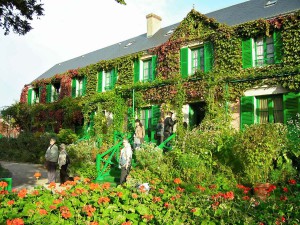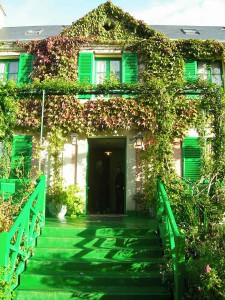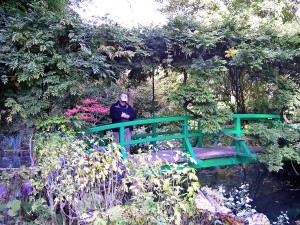FROM PARIS TO NORMANDY ON THE SEINE – VISITING MONET’S HOUSE
FROM PARIS TO NORMANDY ON THE SEINE
This is the fifth in a series of articles about cruising on the Seine
VISITING MONET’S HOUSE
By Charles N. Stevens
Photos by Dolores Seidman
Even as late as eight in the morning dawn is just beginning to break, France slipping into autumn’s grip. Gray clouds streak the sky like brush strokes.
Today we are on our way by bus to visit Claude Monet’s home in Giverny, where he once lived and painted. We especially want to see his water lily garden as on our last visit several years before; the Seine had flooded, inundating it. Since many of his paintings were of these water lilies, we feel it is important to see the place where he painted them.
Even though it is a cold, cloudy day, we look forward to the splashes of color in the sprawling gardens next to his house. Unfortunately our first view of them is a disappointment as most flowers are beyond their prime, their leaves sagging, the petals dried out and the buds drooping. The center of the garden, usually a long swath of intense orange nasturtiums, is but a tangle of tired stems and leaves with only a few hardy blossoms showing their faces. The cold fingers of an early freeze may have visited the garden, only the hardy geraniums and sunflowers still showing their vivid colors. We miss the vibrant palette we experienced the last time we visited. Autumn-red ivy clings to the house.
Walking up the green steps and porch, we enter his house, turning left into a sunken room filled with copies of Monet’s paintings. Along with these, and found as well in other rooms, are Japanese woodblock prints by Hiroshige, Hokusai and Kunisada, so important to the impressionist painters because of the way they viewed a scene. Next is the dining room, stunning at first because its walls, table and chairs are all painted in bright yellow, one of Monet’s favorite colors. After a few moments of adjustment, the room becomes pleasant and cheery, a good place to have a meal. I can imagine Monet dining on coc au vin with friends here, glasses of red wine gleaming before each guest.
In contrast, the kitchen is light blue, every inch of it. Two dozen mirror-polished copper pots and pans hang in a row on the wall and along a shelf. The great wood or coal stove is black metal bouncy castle for sale with brass trim. Dutch tiles decorate the area around the ovens and blue plaid curtains bracket the windows. When walking through the house, we are so conscious of color, the way Monet was, the way he wanted others to feel.
A walkway underneath the highway leads us to Monet’s water garden, a long pond bordered with bamboo, weeping willows and wisteria. Pale asters thrive in the autumn weather, and some trees have been touched with yellow and red. Water lily pads lie flat on the quiet water, but there are no blossoms. At one point a curved green bridge arches over the water, a bridge that appeared in many of Monet’s paintings. Standing on this bridge is like putting myself in one of his canvasses. A stream flows on one edge of the gardens, actually a minor diversion of the Seine, keeping the pond at a constant level. Wandering around the garden, looking at the reflections in the water is quite relaxing, a feeling Monet must have also experienced.
Back in Vernon in the afternoon, Dolores and I stroll into the town to walk its streets and discover what we can. We are surprised to see so many 15th century half-timbered houses still remaining in the city. We also tread carefully down the remnants of a narrow medieval alley with its uneven stones. The Church of our Lady, a fine old Romanesque and gothic structure appears around a corner. We enter it through a large squeaking door. No one is inside the cold, rather dark church, the only signs of warmth being the flickering votive candles at one side. Our footsteps echo in the silence. We learn from a poster inside that all the stained glass windows are new, the old ones having been blown out during World War II. Outside we notice the heads of the saints have all been knocked off, the result of past religious wars. Vernon was liberated by the British in August of 1944.
In the late afternoon we are taken by bus to visit homes in the area. Six of us meet Patrick Demazure near his home in the difficult to pronounce village of Pressagmy l’Orgueilleux. We walk with him down a pleasant street of grand stone houses, most with large yards, many of them in back rather than front of the houses. He takes us in through his gate, where his two dogs greet us. Leaving them outside, at least for a while, we enter his large house. It is so roomy that he uses it for a Bed and Breakfast hotel. His house too is constructed of sandstone blocks, the ceiling in the living room being very high and supported with hand-hewn beams dating from 1856. Mr. Demazure speaks English well, but with a fairly heavy accent. He serves us chilled sparkling cider and small slices of cake. We discuss gas prices, automobiles, free health care, free education and their version of social security. The French have had free health care since 1945. Most agree that it has worked well with only a two-day wait to see a doctor. Operations are free and drugs can be obtained at very low cost. The health system has broken even with no deficit. Poor people and immigrants are also covered. A trio of chickens wanders around the back yard and lays eggs for them. His wife, who was not present, adores chickens, a parade of ceramic ones marching across their mantle. A wire chicken is in the kitchen where flamboyant roosters also decorate plates and platters. Chicken figurines stand outside in the yard.
We experience so much in one day—a visit to Monet’s house in Giverny, a discovery walk into Vernon and a home visit— that it difficult to process it all.
Captions:

Claude Monet's ivy-covered house in Giverny

We enter Monet's house on this colorful porch.

I stand on the very bridge depicted in many of Monet's paintings of his lily pond.

We watch the sunset on the Seine after a long day.



